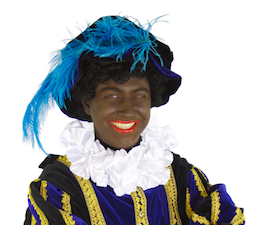Zwartgeschminkte
The Wild Hunt is a legend too old to date. Generally, it explains the winter storms of northern Europe as a hunting party of gods, led by Woden. As the fearsome group traverses the sky and land, they gather the souls of the deceased and take with them anyone living and foolish enough to be caught in their path.
Woden is often accompanied by two ravens, Huginn and Muninn, who act as scouts. They (or a defeated devil) gradually became Herla to the Brits (and eventually King Arthur) and various forms of Herlequin on the northern continent. These forms have a few consistencies: a black face or mask, colorful clothing including a many-pointed hat, and a pronounced smile.
Not much is known of Yule, the midwinter feast of northern pagans. Woden (as his Norse persona Odin) was known as the Yule Father, and some Norse literature refers to it as the raven’s feast. So it’s likely that our friend Herlequin (as Huginn) made an appearance.
As Christianity spread towards Frisia, it brought two midwinter celebrations of its own. Christmas (Dies Natalis Solis Invicti) subsumed many of the Yuletide rituals, including the singing of carols. Others fit more naturally into the feast of Saint Nicholas of Myra, including the hero’s flying through the sky on a white horse, the giving of gifts to the deserving, and his accompanying helpers who deal out punishment to the rest but also climb down chimneys to place gifts in shoes.
Those helpers grew into Krampus to the Germans and Zwarte Piet to the Dutch, who celebrate the feast of Sinterklaas on December 5th.
Since Saint Nicholas was introduced to the Dutch by their Spanish occupiers, there has been some confusion about origins: Nick himself was assumed to be Spanish (or at least have come by way of Spain) and his dark companions to be Moorish servants. In 1850, these assumptions were set in a popular book and eventually Dutch people were joyously celebrating with cookies and gifts while dancing in the streets dressed as Sinterklaas and black-faced Zwarte Piet.

Thanks to the global weight of American culture the Dutch now have also have Santa Claus visiting a score of nights later at Christmas. This complicates a popular re-imagining of Piet as blackened by the soot of climbing down chimneys, because eveyone knows modern Santa is white. He must be, after all, as Washington Irving established him as a jolly pipe-smoking caricature of the Dutch in 18th century New York.
As you can imagine, Americans find this all quite puzzling.
I posted this on medium.com in December 2013 during week 2077.
For more, you should follow me on Bluesky.